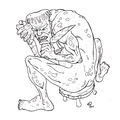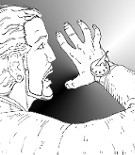Template:Selected anniversaries/February 11: Difference between revisions
No edit summary |
No edit summary |
||
| Line 1: | Line 1: | ||
<gallery> | <gallery> | ||
||AD 55 | ||AD 55: Tiberius Claudius Caesar Britannicus, heir to the Roman emperorship, dies under mysterious circumstances in Rome. This clears the way for Nero to become Emperor. | ||
File:Giovanni Antonio Magini.jpg|link=Giovanni Antonio Magini (nonfiction)|1617: Mathematician, cartographer, and astronomer [[Giovanni Antonio Magini (nonfiction)|Giovanni Antonio Magini]] dies. He supported a geocentric system of the world, in preference to Copernicus's heliocentric system. | File:Giovanni Antonio Magini.jpg|link=Giovanni Antonio Magini (nonfiction)|1617: Mathematician, cartographer, and astronomer [[Giovanni Antonio Magini (nonfiction)|Giovanni Antonio Magini]] dies. He supported a geocentric system of the world, in preference to Copernicus's heliocentric system. | ||
| Line 6: | Line 6: | ||
File:Culvert Origenes.jpg|link=Culvert Origenes|1618: Writer and alleged troll [[Culvert Origenes]] publishes his essay ''[[Man's inhumanity to man (nonfiction)|Man's Inhumanity to Man]]'', which will profoundly influence three generations of Enlightenment-era thinkers. | File:Culvert Origenes.jpg|link=Culvert Origenes|1618: Writer and alleged troll [[Culvert Origenes]] publishes his essay ''[[Man's inhumanity to man (nonfiction)|Man's Inhumanity to Man]]'', which will profoundly influence three generations of Enlightenment-era thinkers. | ||
||1626 | ||1626: Pietro Cataldi dies ... mathematician and astronomer. | ||
File:René Descartes.jpg|link=René Descartes (nonfiction)|1650: Mathematician and philosopher [[René Descartes (nonfiction)|René Descartes]] dies. He is remembered as the father of modern Western philosophy. | File:René Descartes.jpg|link=René Descartes (nonfiction)|1650: Mathematician and philosopher [[René Descartes (nonfiction)|René Descartes]] dies. He is remembered as the father of modern Western philosophy. | ||
||1808 | ||1808: Jesse Fell burns anthracite on an open grate as an experiment in heating homes with coal | ||
||Anders Gustaf Ekeberg | ||1813: Anders Gustaf Ekeberg dies ... chemist who discovered tantalum in 1802. Pic. | ||
||1823 | ||1823: Carnival tragedy of 1823: About 110 boys are killed during a stampede at the Convent of the Minori Osservanti in Valletta, Malta. | ||
||1839 | ||1839: Josiah Willard Gibbs born ... physicist, mathematician, and academic. | ||
File:Thomas Edison.jpg|link=Thomas Edison (nonfiction)|1847: Inventor, engineer, and businessman [[Thomas Edison (nonfiction)|Thomas Edison]] born. He will develop the light bulb and the phonograph, among other inventions. | File:Thomas Edison.jpg|link=Thomas Edison (nonfiction)|1847: Inventor, engineer, and businessman [[Thomas Edison (nonfiction)|Thomas Edison]] born. He will develop the light bulb and the phonograph, among other inventions. | ||
||1864 | ||1864: Louis Bouveault born ... chemist. | ||
||Anders Wiman | ||1865: Anders Wiman born ... mathematician. | ||
||1868 | ||1868: Léon Foucault dies ... physicist and academic. | ||
File:Georg Cantor diagonal argument.jpg|link=Georg Cantor|1884: Set theorist and crime-fighter [[Georg Cantor]] saves [[Edward Lear (nonfiction)|Edward Lear]] from attack by [[crimes against mathematical constants|math criminals]]. | File:Georg Cantor diagonal argument.jpg|link=Georg Cantor|1884: Set theorist and crime-fighter [[Georg Cantor]] saves [[Edward Lear (nonfiction)|Edward Lear]] from attack by [[crimes against mathematical constants|math criminals]]. | ||
| | ||1897: Emil Leon Post born ... mathematician and logician. | ||
|| | File:Leo Szilard.jpg|link=Leo Szilard (nonfiction)|1898: Physicist and academic [[Leo Szilard (nonfiction)|Leo Szilard]] born. He will conceive the nuclear chain reaction in 1933, and patent the idea of a nuclear reactor with Enrico Fermi. | ||
||1899: Wolfgang Gröbner born ... was an Austrian mathematician. His name is best known for the Gröbner basis, used for computations in algebraic geometry. However, the theory of Gröbner bases for polynomial rings was developed by his student Bruno Buchberger in 1965, who named them for Gröbner. | |||
|| | ||1909: Claude Chevalley born ... mathematician who made important contributions to number theory, algebraic geometry, class field theory, finite group theory, and the theory of algebraic groups. Pic. | ||
|| | ||1915: Richard Hamming born ... mathematician and academic. | ||
|| | ||1917: Oswaldo Cruz dies ... physician and epidemiologist. | ||
|| | ||1918: Andrew Donald Booth born ... electrical engineer, physicist and computer scientist who was an early developer of the magnetic drum memory for computers and invented Booth's multiplication algorithm. Pic: https://www.i-programmer.info/history/people/1253-andrew-booth.html | ||
||Ernst Paul Specker | ||1920: Ernst Paul Specker born ... mathematician. Much of his most influential work was on Quine’s New Foundations, a set theory with a universal set, but he is most famous for the Kochen–Specker theorem in quantum mechanics, showing that certain types of hidden variable theories are impossible. | ||
||Yozo Matsushima | ||1921: Yozo Matsushima born ... mathematician. | ||
||Jacques Friedel | ||1921: Jacques Friedel born ... physicist and material scientist. Pic. | ||
||1923 | ||1923: Wilhelm Killing dies ... mathematician and academic. | ||
||Jacques Loeb | ||1924: Jacques Loeb dies ... American physiologist and biologist. Messaging. Pic. | ||
File:Oskar_Anderson.jpg|link=Oskar Anderson (nonfiction)|1930: Mathematician, statistician, and crime-fighter [[Oskar Anderson (nonfiction)|Oskar Anderson]] publishes new theory of mathematical statistics based on [[Gnomon algorithm functions]] with applications in the detection and prevention of [[crimes against mathematical constants]]. | File:Oskar_Anderson.jpg|link=Oskar Anderson (nonfiction)|1930: Mathematician, statistician, and crime-fighter [[Oskar Anderson (nonfiction)|Oskar Anderson]] publishes new theory of mathematical statistics based on [[Gnomon algorithm functions]] with applications in the detection and prevention of [[crimes against mathematical constants]]. | ||
| Line 56: | Line 56: | ||
File:Charles Algernon Parsons.jpg|link=Charles Algernon Parsons (nonfiction)|1931: Engineer and inventor [[Charles Algernon Parsons (nonfiction)|Charles Algernon Parsons]] dies. He invented the compound steam turbine, and worked on dynamo and turbine design, power generation, and optical equipment for searchlights and telescopes. | File:Charles Algernon Parsons.jpg|link=Charles Algernon Parsons (nonfiction)|1931: Engineer and inventor [[Charles Algernon Parsons (nonfiction)|Charles Algernon Parsons]] dies. He invented the compound steam turbine, and worked on dynamo and turbine design, power generation, and optical equipment for searchlights and telescopes. | ||
||1938 | ||1938: BBC Television produces the world's first ever science fiction television program, an adaptation of a section of the Karel Čapek play R.U.R., that coined the term "robot". | ||
||Egbert Rudolf van Kampen | ||1942: Egbert Rudolf van Kampen dies .. mathematician. He made important contributions to topology, especially to the study of fundamental groups. Pic. | ||
File:Charles Critchfield ID badge.gif|link=Charles Critchfield (nonfiction)|1944: Mathematical physicist and crime-fighter [[Charles Critchfield (nonfiction)|Charles Critchfield]] uses burst of neutrons to detect and prevent [[crimes against physical constants]]. | File:Charles Critchfield ID badge.gif|link=Charles Critchfield (nonfiction)|1944: Mathematical physicist and crime-fighter [[Charles Critchfield (nonfiction)|Charles Critchfield]] uses burst of neutrons to detect and prevent [[crimes against physical constants]]. | ||
||Ronald J. DiPerna | ||1947: Ronald J. DiPerna dies ... mathematician, who worked on nonlinear partial differential equations. | ||
||1953 | ||1953: U.S.President Dwight D. Eisenhower denies all appeals for clemency for Julius and Ethel Rosenberg. | ||
||1971 | ||1971: Eighty-seven countries, including the United States, United Kingdom, and Soviet Union, sign the Seabed Arms Control Treaty outlawing nuclear weapons on the ocean floor in international waters. | ||
File:Johannes Hans Daniel Jensen.jpg|link=J. Hans D. Jensen (nonfiction)|1973: Nuclear physicist and Nobel Prize laureate [[J. Hans D. Jensen (nonfiction)|J. Hans D. Jensen]] dies. He shared half of the 1963 Nobel Prize in Physics with Maria Goeppert-Mayer for their proposal of the nuclear shell model. | File:Johannes Hans Daniel Jensen.jpg|link=J. Hans D. Jensen (nonfiction)|1973: Nuclear physicist and Nobel Prize laureate [[J. Hans D. Jensen (nonfiction)|J. Hans D. Jensen]] dies. He shared half of the 1963 Nobel Prize in Physics with Maria Goeppert-Mayer for their proposal of the nuclear shell model. | ||
||Vladimir Ivanovich Smirnov | ||1974: Vladimir Ivanovich Smirnov dies ... mathematician who made significant contributions in both pure and applied mathematics, and also in the history of mathematics. Pic. | ||
||James Bryant Conant | ||1978: James Bryant Conant dies ... chemist, a transformative President of Harvard University, and the first U.S. Ambassador to West Germany. | ||
||1981 | ||1981: Around 100,000 US gallons (380 m3) of radioactive coolant leak into the containment building of TVA Sequoyah 1 nuclear plant in Tennessee, contaminating eight workers. | ||
||1993 | ||1993: Robert W. Holley dies ... biochemist and academic, Nobel Prize laureate. | ||
||1997 | ||1997: Space Shuttle Discovery is launched on a mission to service the Hubble Space Telescope. | ||
||2001 | ||2001: A Dutch programmer launches the Anna Kournikova virus, infecting millions of emails via a trick photo of the tennis star. | ||
||2006 | ||2006: Then U.S. Vice President Dick Cheney shot Harry Whittington, a 78-year-old Texas attorney, while participating in a quail hunt on a ranch in Riviera, Texas. | ||
||Alexander Andreevich Samarskii | ||2008: Alexander Andreevich Samarskii dies ... mathematician and academician specializing in mathematical physics, applied mathematics, numerical analysis, mathematical modeling, and finite difference methods. Pic. | ||
</gallery> | </gallery> | ||
Revision as of 18:49, 30 August 2018
1617: Mathematician, cartographer, and astronomer Giovanni Antonio Magini dies. He supported a geocentric system of the world, in preference to Copernicus's heliocentric system.
1618: Writer and alleged troll Culvert Origenes publishes his essay Man's Inhumanity to Man, which will profoundly influence three generations of Enlightenment-era thinkers.
1650: Mathematician and philosopher René Descartes dies. He is remembered as the father of modern Western philosophy.
1847: Inventor, engineer, and businessman Thomas Edison born. He will develop the light bulb and the phonograph, among other inventions.
1884: Set theorist and crime-fighter Georg Cantor saves Edward Lear from attack by math criminals.
1898: Physicist and academic Leo Szilard born. He will conceive the nuclear chain reaction in 1933, and patent the idea of a nuclear reactor with Enrico Fermi.
1930: Mathematician, statistician, and crime-fighter Oskar Anderson publishes new theory of mathematical statistics based on Gnomon algorithm functions with applications in the detection and prevention of crimes against mathematical constants.
1931: Engineer and inventor Charles Algernon Parsons dies. He invented the compound steam turbine, and worked on dynamo and turbine design, power generation, and optical equipment for searchlights and telescopes.
- Charles Critchfield ID badge.gif
1944: Mathematical physicist and crime-fighter Charles Critchfield uses burst of neutrons to detect and prevent crimes against physical constants.
1973: Nuclear physicist and Nobel Prize laureate J. Hans D. Jensen dies. He shared half of the 1963 Nobel Prize in Physics with Maria Goeppert-Mayer for their proposal of the nuclear shell model.









